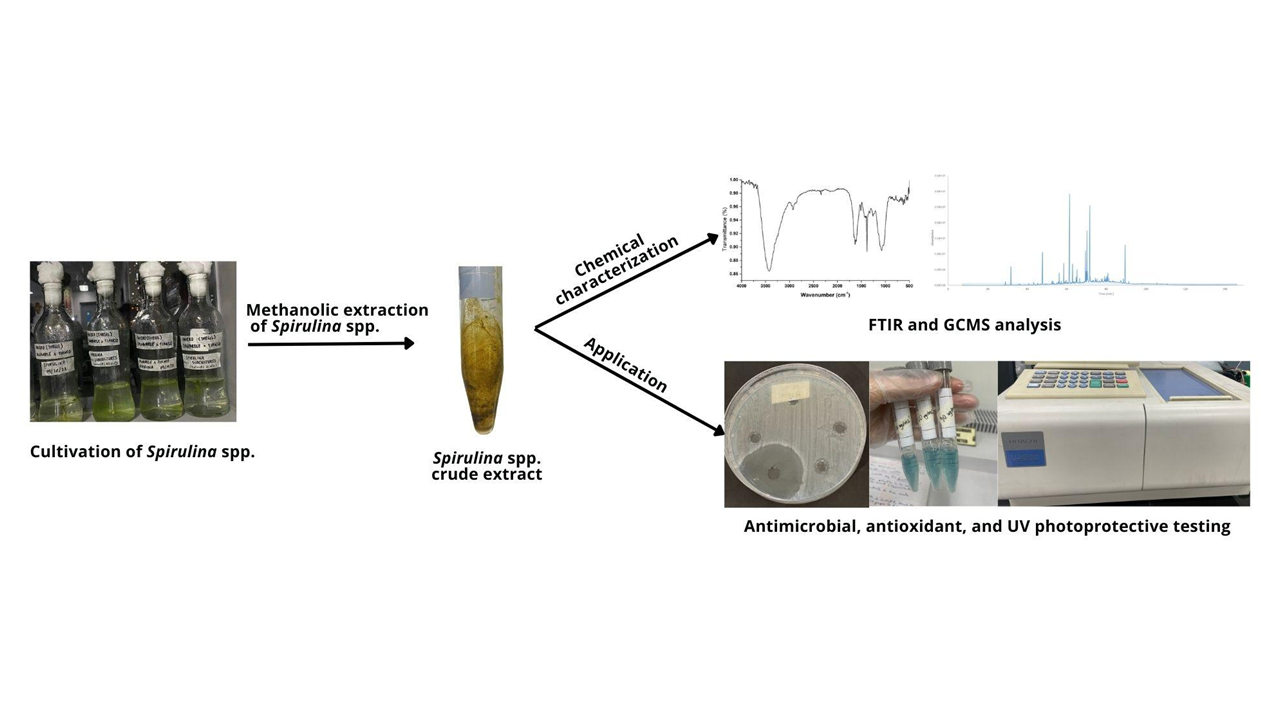Evaluation of Spirulina spp. Crude Extract Revealed Antimicrobial, Antioxidant and UV Photoprotective Properties
DOI:
https://doi.org/10.48048/tis.2024.7582Keywords:
Spirulina spp., Antimicrobial, UV Photoprotective, Antioxidant, Gas chromatography-mass spectrometryAbstract
The antimicrobial, UV photoprotective and antioxidant capabilities of Spirulina spp. methanolic extracts were determined using Fourier transform infrared spectroscopy (FTIR) and gas chromatography-mass spectrometry (GC-MS). Notable compounds were reported to be 5 fatty acid methyl esters, 4- methoxyallocinnamic acid, 2-ethylhexyl esters and bumetrizole. Moreover, these metabolites contained functionalities including hydroxyl, alkyl and carbonyl, as supported by the FTIR result. After 24 h, there was no zone of inhibition in the antibacterial activity as measured by the agar well diffusion method at doses of 30, 50 and 70 g/mL. The ABTS radical scavenging assay revealed that the methanolic Spirulina spp. exhibited an inhibitory concentration of 1,047.91 g/mL for antioxidant activity and SPF values of 0.40, 0.23 and 0.93 were calculated using Mansur’s equation for concentrations of 30, 50 and 70 g/mL, respectively. The results of the study showed the potential of cyanobacterial extracts as a bioactive ingredient in cosmetic product development.
HIGHLIGHTS
- Methanolic extraction of Spirulina spp. comprises 5 fatty acid methyl esters, 4-ethoxyallocinnamic acid 2-ethylhexyl esters and bumetrizole characterized by GC-MS.
- Constituents of the extract contain functional groups including –OH, –C–H and C=O.
- The extracts were classified as weak radical stabilizers, confirmed by ABTS assay and possessed UV photoprotective capacity confirmed by the in vitro SPF assay.
GRAPHICAL ABSTRACT

Downloads
Metrics
References
T Stoiber. What are parabens, and why don’t they belong in cosmetics? Environmental Working Group, Available at: https://www.ewg.org/what-are-parabens, accessed 2023.
D Koniecki, R Wang, RP Moody and J Zhu. Phthalates in cosmetic and personal care products: Concentrations and possible dermal exposure. Environ. Res. 2011; 111, 329-36.
MP Kapoor, M Sugita, Y Fukuzawa, D Timm, M Ozeki and T Okubo. Green tea catechin association with ultraviolet radiation-induced erythema: A systematic review and meta-analysis. Molecules 2021; 26, 3702.
D Rodrigues, AC Viotto, R Checchia, A Gomide, D Severino, R Itri, MS Baptista and WK Martins. Mechanism of aloe vera extract protection against UVA: Shelter of lysosomal membrane avoids photodamage. Photochem. Photobiol. Sci. 2016; 15, 334-50.
F Álvarez-Gómez, N Korbee, V Casas-Arrojo, RT Abdala-Díaz and FL Figueroa. UV Photoprotection, Cytotoxicity and Immunology Capacity of Red Algae Extracts. Molecules 2019; 24, 341.
FJ Sami, NH Soekamto, Firdaus and J Latip. Bioactivity profile of three types of seaweed as an antioxidant, UV-protection as sunscreen and their correlation activity. Food Res. 2021; 5, 441-7.
Z Chong, H Matsuo, M Kuroda, S Yamashita, GP Parajuli, HK Manandhar, K Shimizu and Y Katakura. Mushroom extract inhibits ultraviolet B-induced cellular senescence in human keratinocytes. Cytotechnology 2018; 70, 1001-8.
S Fuentes-Tristan, R Parra-Saldivar, HMN Iqbal and D Carrillo-Nieves. Bioinspired biomolecules: Mycosporine-like amino acids and scytonemin from Lyngbya sp. with UV protection potentialities. J. Photochem. Photobiol. B Biol. 2019; 201, 111684.
C Korteerakul, M Honda, S Ngoennet, T Hibino, R Waditee-Sirisattha and H Kageyama. Antioxidative and antiglycative properties of mycosporine-like amino acids-containing aqueous extracts derived from edible terrestrial cyanobacteria. J. Nutr. Sci. Vitaminol. 2020; 66, 339-46.
RP Rastogi, RR Sonani and D Madamwar. Cyanobacterial sunscreen Scytonemin: Role in photoprotection and Biomedical research. Appl. Biochem. Biotechnol. 2015; 176, 1551-63.
B Nowruzi, G Sarvari, and S Blanco. The cosmetic application of cyanobacterial secondary metabolites. Algal Res. 2020; 49, 101959.
I Ragusa, GN Nardone, S Zanatta, W Bertin and E Amadio. Spirulina for skin care: A bright blue future. Cosmetics 2021; 8, 7.
ME Silva-Stenico, CSP Silva, AS Lorenzi, TK Shishido, A Etchegaray, SP Lira, LAB Moraes and MF Fiore. Non-ribosomal peptides produced by Brazilian cyanobacterial isolates with antimicrobial activity. Microbiol. Res. 2011; 166, 161-75.
MCS Tan, MSS Carranza, VC Linis, RS Malabed and GG Oyong. Antioxidant, cytotoxicity, and antiophidian potential of Alstonia macrophylla bark. ACS omega 2019; 4, 9488-96.
R Re, N Pellegrini, AR Proteggente, AS Pannala, M Yang and C Rice-Evans. Antioxidant activity applying an improved ABTS radical cation decolorization assay. Free Radic. Biol. Med. 1999; 26, 1231-7.
J Sukweenadhi, O Yunita, F Setiawan, Kartini, MT Siagian, NP Danduru and C Avanti. Antioxidant activity screening of seven Indonesian herbal extract. Biodiversitas Journal of Biological Diversity, 2020; 21, 2062-7.
JDS Mansur, MNR Breder, MCDA Mansur and RD Azulay. Determinação Do Fator De Proteção Solar Por Espectrofotometria. An. Bras. Dermatol. 1986; 61, 121-4
RM Sayre, JC Dowdy and JG Shepherd. Extent of ultraviolet radiation protection in popular sunscreens: Impact of composition on U.S. food and drug administration-critical wavelength measurements. J. Am. Acad. Dermatol. 2010; 62, 348-53
AE Abdel-Moneim, MT El-Saadony, AM Shehata, AM Saad, SA Aldhumri, SM Ouda and NM Mesalam. Antioxidant and antimicrobial activities of Spirulina platensis extracts and biogenic selenium nanoparticles against selected pathogenic bacteria and fungi. Saudi J. Biol. Sci. 2022; 29, 1197-209.
S Frazzini, E Scaglia, M Dell’Anno, S Reggi, S Panseri, C Giromini, D Lanzoni, CAS Rossi and L Rossi. Antioxidant and antimicrobial activity of algal and cyanobacterial extracts: An in vitro study. Antioxidants 2022; 11, 992.
MR Javed, M Salman, A Tariq, A Tawab, MK Zahoor, S Naheed, M Shahid, A Ijaz and H Ali. The antibacterial and larvicidal potential of bis-(2-Ethylhexyl) Phthalate from Lactiplantibacillus plantarum. Molecules 2022; 27, 7220.
M Bubonja-Šonje, S Knežević and M Abram. Challenges to antimicrobial susceptibility testing of plant-derived polyphenolic compounds. Arh. Hig. Rada Toksikol. 2020; 71, 300-11.
N Jadid, D Hidayati, SR Hartanti, BA Arraniry, RY Rachman and W Wikanta. Antioxidant activities of different solvent extracts of Piper retrofractum Vahl. using DPPH assay. AIP Conf. Proc. 2017; 1854, 020019.
J Dong, L Cai, Y Xing, J Yu and Z Ding. Re-evaluation of ABTS*+ assay for total antioxidant capacity of natural products. Nat. Prod. Commun. 2015; 10, 2169-72.
V Castro, R Oliveira and ACP Dias. Microalgae and cyanobacteria as sources of bioactive compounds for cosmetic applications: A systematic review. Algal Res. 2023; 76, 103287-7.

Downloads
Published
How to Cite
Issue
Section
License
Copyright (c) 2024 Walailak University

This work is licensed under a Creative Commons Attribution-NonCommercial-NoDerivatives 4.0 International License.






